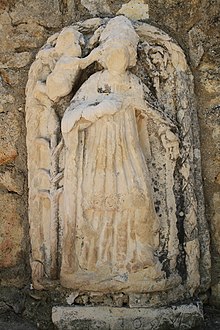Canus Natus
Canus Natus | |
|---|---|
 Statue in Saint-Cannat | |
| Pilgrim | |
| Born | Fifth century |
| Died | October 15, 490 Saint-Cannat, France |
Canus Natus was a French Saint in the fifth century.

Early life
[edit]Canus Natus was born in the fifth century.[1][2] He was white-haired upon his birth, a sign of wisdom at the time.[1][2][3][4] The phrase "canus natus" in Latin means "he was born old."[5]
Religious vocation
[edit]He became a hermit in a place called Sauzet, described by Christophe de Villeneuve-Bargemon (1771–1829) as a "desert" with "willow trees."[1][2][3]
According to Henri François Xavier de Belsunce de Castelmoron (1671–1755), one of his miracles occurred when a dead reed he used as a cane was brought back to life, looking green again.[4] This miracle led him to accept a tenure as the Bishop of Marseille in the second half of the fifth century.[1][2][3][4] During his tenure, he strongly opposed paganism and heresy.[1]
Death and legacy
[edit]Upon retirement, he settled in Sauzet again, and died there on October 15, 490.[2][3] After he was buried there, it became a hamlet and took his name.[1][3][6] It is now known as the village of Saint-Cannat.[1][6] Additionally, the Église Saint-Cannat in Marseille, built from 1526 to 1619, is named in his honour.[3]

References
[edit]- ^ a b c d e f g "Saint-Cannat Official website: Origins of the Bishops of Marseille". Archived from the original on 2014-08-19. Retrieved 2014-08-19.
- ^ a b c d e Christophe de Villeneuve-Bargemon, Statistique du département des Bouches-du-Rhône, Ricard, 1824, p. 951 [1]
- ^ a b c d e f Variétés religieuses; ou, choix de poésies provençales, avec notes, Aix-en-Provence: Makaire, 1860, pp. 165-180 [2]
- ^ a b c Henri François Xavier de Belsunce de Castelmoron, L'antiquité de l'Église de Marseille, et la succession de ses évêques, Ve. J.P. Brebion, 1747, pp. 201-206 [3]
- ^ Google Translate
- ^ a b "Aix-en-Provence Information Office". Archived from the original on 2015-04-05. Retrieved 2014-08-19.
